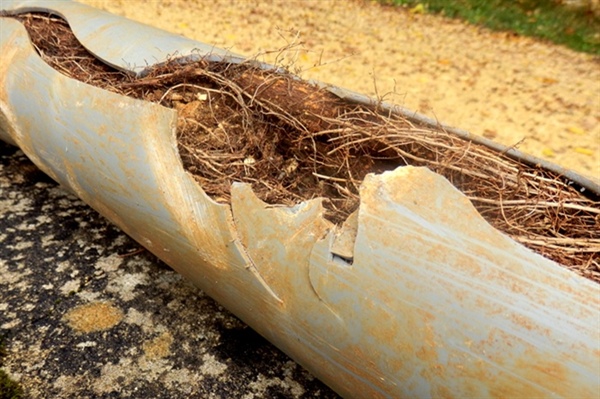How Does Trenchless Sewer Repair Address Root Intrusion Issues?

Imagine noticing your basement floor drain slowly backing up after a heavy rain, only to discover a tangle of tree roots inside your sewer pipe. Advanced Trenchless Solutions in Wisconsin Rapids explores how trenchless repair methods can effectively manage root intrusion issues, protect your property and ensure the longevity of your sewer system.
By creating a seamless, joint-free interior, trenchless sewer repair seals entry points and restores structural integrity without the disruption of open excavation.
In this article, we will examine five critical facets of root intrusion management:
What causes root intrusion in sewer lines and how it affects plumbing systems?
How trenchless pipe lining prevents future root intrusion.
In what ways pipe bursting eliminates existing root-related blockages.
How effective trenchless methods are in areas with aggressive root growth.
What maintenance practices can complement trenchless repair to manage root intrusion.
Understanding each of these areas will equip you with the knowledge to protect your sewer network against invasive roots.
Understanding Root Intrusion in Sewer Lines & Its Impact on Plumbing Systems
Root intrusion begins when microscopic root hairs sense moisture and oxygen escaping through hairline cracks or loose joints in aging sewer pipes. Over time, roots exploit these vulnerabilities, weaving into the pipe interior and expanding as they seek nutrients.
As roots thicken, they trap solids and debris, forming dense masses that restrict flow. This can lead to slow drains, gurgling sounds, and frequent backups. In severe cases, root pressure aggravates fractures and seams, causing pipe collapse and leaks that saturate soil around foundations.
Mitigating root intrusion often involves specialized repairs. Techniques like trenchless sewer repair seal entry points and restore structural integrity without extensive excavation. By creating a seamless barrier, these methods prevent new root access and preserve system performance.
How Cured-in-Place Pipe Lining Prevents Future Root Intrusion
Cured-in-place pipe lining (CIPP) involves inserting a resin-saturated liner into the existing pipeline and curing it in place with heat or UV light. The liner conforms to the host pipe, filling cracks and voids to form a continuous new pipe within the old one.
Once cured, the liner provides structural support across the entire length of the pipe, reinforcing weak sections and resisting soil and root pressure. The uniform, joint-free interior eliminates gaps where roots could weave their way into the pipe wall.
The smooth surface of the cured liner prevents roots from gaining traction, denying them the microscopic footholds they require. This low-friction interior also reduces debris buildup, further lowering the risk of blockages and repeated root penetration.
Pipe Bursting Techniques for Eliminating Root-Related Blockages
Pipe bursting replaces a damaged sewer line by fracturing the host pipe outward while pulling a new pipe into place. The bursting head forces fragments of the old pipe and any entangled root masses into the surrounding soil, effectively removing blockages rather than just cutting through them.
Typically conducted with high-density polyethylene (HDPE) replacement pipe, bursting creates a seamless, corrosion-resistant conduit that often exceeds the hydraulic capacity of the original line. Upsizing during replacement further improves flow and reduces future clogging risks.
Minimal excavation—limited to entry and exit pits—preserves landscaping and hardscapes. By fully removing the root-infested liner and installing a fresh, joint-free pipe, pipe bursting delivers a durable solution in one operation, even under driveways and beneath structures.
Effectiveness of Trenchless Methods in Areas With Aggressive Root Growth
In regions with aggressive root growth—common near mature trees and shrubs—trenchless methods can still perform reliably. CIPP liners rated to ASTM standards resist common root species, while the absence of joints removes preferred root entry points.
However, in exceptionally root-dense soils, routine inspections are crucial. CCTV evaluations identify any signs of microscopic breaches, enabling targeted hydro-jetting or mechanical clearing before roots gain a foothold in the liner.
For the most challenging scenarios, replacing the line via pipe bursting and installing root barrier membranes along the alignment provide extra protection. Combined with chemical root inhibitors and controlled landscaping, these strategies keep even vigorous root systems at bay.
Complementary Maintenance Practices for Managing Root Intrusion After Trenchless Repair
A proactive maintenance regimen preserves trenchless repairs and extends service life. Annual or biannual CCTV inspections detect early-stage root intrusion, joint separations, and surface wear without excavation.
Hydro-jetting at appropriate pressures clears fine root hairs and debris that can adhere to pipe walls, maintaining hydraulic capacity and ensuring the liner’s smooth interior remains intact. This nonabrasive cleaning method prevents root reattachment.
For ongoing protection, chemical root control injects herbicidal agents that kill roots inside and just beyond the pipe wall. To arrange a tailored maintenance plan and chemical treatments, contact Advanced Trenchless Solutions.
Advanced Trenchless Solutions Is Ready to Assist in Wisconsin
Advanced Trenchless Solutions in Wisconsin Rapids applies proven trenchless sewer repair, pipe lining, and pipe bursting technologies to address root intrusion at its source. With specialized resin liners, pipe bursting equipment, and maintenance programs, our team restores flow capacity and protects pipelines against future root invasion.
Ready to safeguard your sewer system? Contact us!
Call Advanced Trenchless Solutions at 844.513.4106 or visit us at 1138 6th Street South, Wisconsin Rapids, WI 54494. .